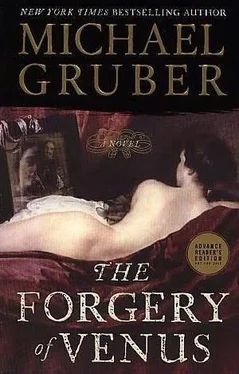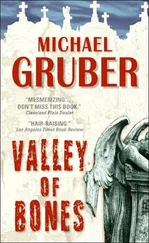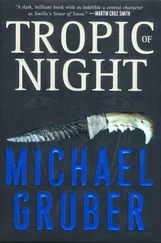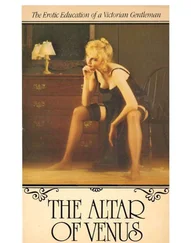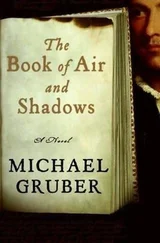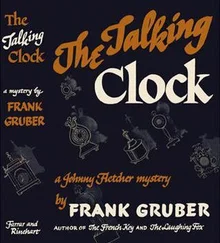I got the whole tour. Top floor servants’ quarters, Bieneke and the frau live in a farmhouse on the property. The master has his suite, office, bedroom, study, on the ground floor; I was shown the door, but not the inside. At the back of the house, a wonder, a huge artist’s studio; the man tells me that Herr Krebs’s father added it to the house. A wall of windows connecting to a skylight two floors above, a professional easel, the usual worktables, cabinets. Signs of long-ago painting, faded spatters, but no sniff of turps, no one has used this room in a long time. I ask. The old man painted a little, and Herr Krebs when young, but not recently. Interesting.
Below the main floor are the kitchen, storerooms, the usual, and a door in the back leading to the basement. We descend the stairs. All old stonework, original, must be seventeenth century at least, arches and niches suitable for hogsheads of wine and beer, now filled with wine racks and central heating equipment. In a corner I see a small ironbound door, low, set into the wall, looks original to the house. What’s down there? Nothing, sir, an old well, dangerous, kept locked at all times. Aha, there’s the secret, I thought, the Bluebeard room, where the dead wives are kept, the Nazi memorabilia, the crates of gold coins.
Then up a staircase with heavy carved banisters to the second floor and down a hall to a room, mine. Nice room, simply furnished: a wooden bed with posts, checked bedspread, goosefeather pillows, a desk, chair, the usual lamps, a door to a bathroom, fortunately the latest, not at all what you’d expect, obviously a great deal of expensive renovations in the recent past.
Dinner was me and Krebs, served by the two girls, decent heavy food, soup, chops, spaetzle, a rich cake. Conversation sputtered a little; I was almost mute, because if you’re no one, you don’t have much to say. So he gave me a history of the house, it dated from 1694, the country seat of a servant of the Bavarian monarchy. Extensively modified, of course. He went on about the delights of the countryside, the seasons. He hunts boar and will take me if I like, if I am still here in the fall. Or there is a river, we can catch trout. I didn’t object to his assumption that I would be an indefinite guest. No more talk about psychiatry. We’re pals now. The wine helped. I drank most of a bottle of Rhône.
After dinner, he invited me to his end of the house for a cigar, a cognac. More comfortable there, he said, and yes it was, a large room that looked like a museum of modern design. The walls were oyster; the furniture was all leather, brushed steel, glass, marble, and rare woods, beautiful designs, the best studio stuff, all handmade and ferociously expensive: a desk, a comfortable-looking sling chair, an elegant couch, of the type a wealthy psychiatric patient might be expected to lie in and tell Herr Dr. Krebs about early trauma. The ceiling was high and one wall was entirely glass, looking out into the night, a moonlit meadow, black woodlands beyond. There was a wall of books, mostly gigantic treatises on various artists, and several shelves of medical tomes in many different European languages, plus a tropical marine fish tank built into the wall and swimming with clownfish and a variety of other colorful creatures. An elaborate sound system in dull gray steel looked custom-made and was softly playing a Mozart violin concerto. Above the sound system, rank on rank, were framed awards and diplomas. Their language was Latin but I could make out on each the name of Werner Krebs.
Three paintings hung on the remaining pale wall: a Cézanne view of Mt. St. Victoire, a Matisse odalisque in a pink room, and in the center, a large gilt-framed altarpiece, a Virgin with child and donors by some Flemish master.
Krebs handed me a balloon glass charged with cognac and asked me if I could identify the altarpiece.
I sipped cognac and said, “It looks like a van der Goes.”
“Yes. An early work, but already he shows the sympathy for the ordinary man for which he was famous. Obviously the Virgin and the angel are at the center, but observe the servants staring longingly in at the window, their care-worn faces. A very van der Goes touch. He was a member of the Brethren of the Common Life, you know, almost a monk. He went mad from the conflict between his growing fame as a painter and the demands he made on himself to be humble. A sad case.”
“Is it real?”
“Does it matter? The technique is there, the iconography is correct, the religious fervor shines from every corner of the panel. You feel it, I feel it. If a spectrograph showed titanium white in it, would those qualities, those feelings vanish?”
“A nice point, but I also think you wouldn’t hang a fake in your study. Where did you get it? Nazi swag?”
“As a matter of fact, yes,” he said agreeably. “As are the others. I couldn’t bear to part with them. A vice of all art dealers, I’m afraid.”
“So your old dad really did get away with the Schloss paintings.”
He gave me a strange look, surprise, a brief irritation, then amusement. “Alas, no, he did not.”
“What about those two vans out of Munich?”
He smiled now. “Excellent, you have been studying my history. Very commendable. As it happens, however, we were only able to move one of the vans into Switzerland; the other was caught in the Dresden bombing, and this contained the Schloss material. A great pity that so much beauty should be permanently lost to the world. But would you like to see something of more particular interest?”
Now I was drunk; the wine and the cognac had loosened me up. The craziness was still boiling underneath, but the supposed real me had recovered a little nerve. I said, “Does that mean pornography, Doctor?”
“Of a type,” he said, and walked to the far end of the room. He opened a door and motioned me through. It was his bedroom, a lot larger than mine and furnished like a television starship. There were several small paintings on the walls but I had eyes only for one.
“Where the hell did you get that ?” I said.
“It turned up in London some years ago, an auction at Christie’s. Remarkable, isn’t it?”
Yeah, it was. A small oil, maybe twenty-five by thirty inches; in the left foreground a couple of teenage marines were standing, one lighting a cigarette, the other looking out at us with the usual thousand-yard stare. In the center of the picture lay a Japanese soldier writhing in flames, ignored, his crisped hand reaching up to uncaring heaven, and behind him was a marine with a flamethrower, the obvious cause of this event, and in the same plane a group of other marines hanging around, smoking, talking to each other, taking a break. Above, a dirty early-evening sky; behind, a scorched and pocked hillside and the mouth of a cave smoking like the gates to hell. The thing had been painted with the authority and bravura brushwork of The Surrender of Breda by Velázquez. It seemed to me to be a historical painting of similar quality, and you could tell that the artist was thinking of that earlier painting when he did it: this is what war’s like now, folks: gormless, brutalized farm boys having a human barbeque, and note the absence of courtly gentlemen bowing to one another on the field of honor. Signed with my dad’s familiar monogram and the date, 1945.
Krebs studied my face as I looked at the painting and asked, “You find it depressing?”
“Not the subject matter so much as the waste. How he could do this and then have the life he had.”
“You might ask yourself the very same question.”
“I might and I do. Is this part of my therapy, Doctor?”
“If you want it to be.”
“What I want is for you to tell me why you’re doing this, the fake psychiatrist routine.”
Читать дальше
